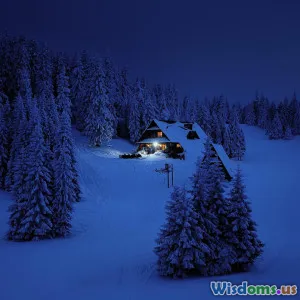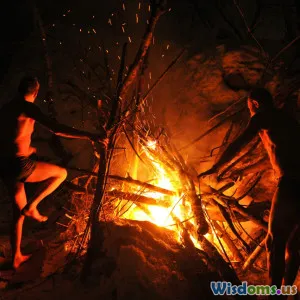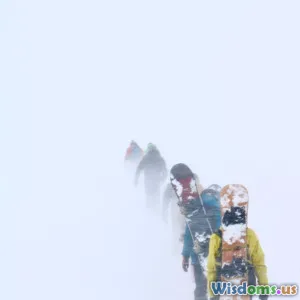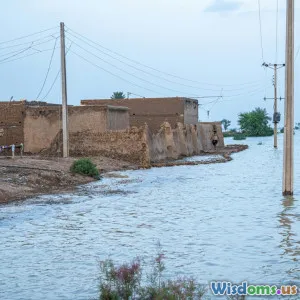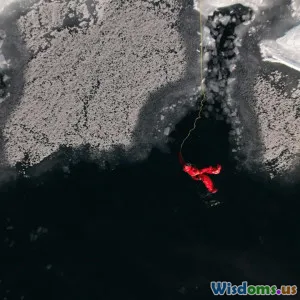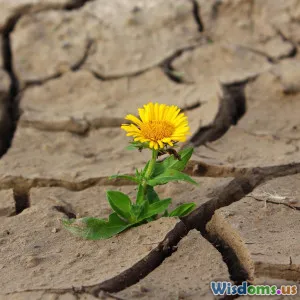
Personal Story Escaping a Blizzard With Minimal Supplies
15 min read A riveting account of surviving a blizzard with few supplies, this article details lessons learned, practical survival tips, and the human spirit's surprising strength in dire circumstances. (0 Reviews)
Trapped by Winter: My Personal Story of Escaping a Blizzard With Minimal Supplies
Introduction: Into the Heart of the Whiteout
I always thought I had a decent appreciation for nature’s power. But until you’re staring into the swirling chaos of a blizzard with only minimal supplies and uncertain shelter, it’s impossible to understand both the danger and strange beauty of a frozen wilderness. This is a true story—one that began as a simple winter hike and transformed into an impromptu test of my survival skills, willpower, and the value of the simplest essentials. Whether you’re a seasoned outdoors person or someone who’s never left the city in winter, I share my experience in hopes that the lessons I learned may one day help someone else outlast the storm.
Before the Storm: The Lure of a Winter Escape
Some adventures start with months of planning, high-tech gear, and backup plans. This was not one of them. Seeking solitude and serenity, I set off for a solo day hike in the northern woods with little more than a basic pack:
- A half-filled water bottle
- A slim energy bar and a packet of trail mix
- A worn map and an old compass
- A lightweight windbreaker and knit cap
- My phone (with just 30% battery and spotty reception)
The weather report had mentioned a “chance of flurries.” Locals joked about winter's mood swings but reassured me with, “You’ll be fine before noon.” The sky that morning was brisk and blue, crisp enough to make every breath feel sharp and invigorating. Feeling at peace, I never imagined how quickly that serene white landscape would turn.
The Onset: When Whiteout Strikes
By midday, cloud banks rose quickly over the ridgeline. Within an hour, the temperature plummeted and flakes thickened to curtains. Visibility dropped from a mile to a hundred feet, then to a shimmering wall of white less than twenty. The roaring wind muffled distant snapping branches, and the trails I'd planned to follow vanished under relentless, swirling snow.
Losing Direction
Despite the gear I had, I was astonishingly underprepared. Smartphone navigation became useless as snow battered the screen, and battery life dwindled in the cold. My compass worked, but in visibility like this, North was only a concept. The color had been leeched from the world—now only white and grey shapes roared past, disorienting and hypnotic.
The official statistics are sobering: According to the National Weather Service (NWS), visibility in a true blizzard can drop below a quarter mile, often much less in forested terrain. At the same time, wind chills can drive effective temperatures to 40°F below zero, rapidly sapping body heat and decision-making ability. It wasn’t long before every step felt like a tentative move in a maze where walls and exits shifted with every gust.
Minimal Supplies, Maximum Creativity: Adapting on the Fly
Everywhere I looked, snow obscured familiar landmarks. Even fresh tracks vanished within minutes. Panic beckoned, but experience (and the memory of countless survival stories) told me to focus on three key principles: Shelter, heat, and rationing.
Conserving Body Heat
Hypothermia is the most immediate threat in such weather. Within minutes, a wet windbreaker and absent gloves left my fingers stinging and useless. Survival handbooks, like those from the Red Cross, stress the “COLD” acronym: Keep Clothing Clean, avoid Overheating, wear Loose and Layered, and keep Dry.
I arrayed every layer I had and stuffed dry leaves—scavenged from under the snow—between my shirt and jacket to add insulation. Over the next hour, I’d return to this surprisingly effective trick. Sharpening focus on movement without sweating, I moved simply to generate heat, not out of desperation.
Improvising Shelter
Branches thick with heavy snow inspired an idea. With mittened hands (thanks to improvised sleeves covering them), I formed a shallow hollow behind a fallen tree, building a windbreak using snow itself. Contrary to myth, snow is an effective insulator. According to survival expert Les Stroud, a snow trench or “quinzee” can maintain temperatures near 32°F when external air is far colder.
I began burrowing along the downwind side, packing snow to build walls about a foot high—the same technique used in snow shelters by Arctic tribes. A sturdy stick scraped a shallow burrow big enough to crouch in. Every five minutes, I stopped, rubbing fingers and toes to prevent numbness. When I’d hollowed out a small trench, I lined the base with pine boughs to reduce heat loss into the ground.
Rationing Water and Food
My water, nearly gone, became precious. Eating snow for hydration is a common mistake that only speeds hypothermia (it takes far more body heat to melt it in your stomach than the liquid you gain). Instead, I caught some snowflakes on my tongue and let the rest melt slowly in the bottle, holding it close to my cores during breaks.
A single energy bar had never tasted as satisfying as when I nibbled it with care, breaking off tiny pieces and savoring each. Energy conservation was crucial—for warmth and lucid thinking.
The Long Night: Battling Isolation and Fatigue
As daylight faded, fatigue weighed my thoughts. The psychological aspect of survival cannot be overstated. The loneliness was intense—the silence broken only by wind and the distant moan of shifting trees. Each hour felt like two.
Staving Off Fear and Mistakes
Fear of getting lost forever nudged the fringes of my focus. Drawing on lessons I’d only read about before, I broke time into small, manageable chunks. “Make it to the next 10 minutes, then re-evaluate,” I told myself. Periodically, I checked my map and compass, marking rough estimated positions based on terrain and any recognizable features.
Motivation is vital: According to a study published by the Wilderness Medical Society, individuals with positive, proactive mindsets are far more likely to survive cold weather exposure (Vol. 22, Issue 2). I remembered stories of Ernest Shackleton's Antarctic ordeal—a masterclass in endurance and keeping hope alive under monstrous odds.
Preserving Core Temperature
To fight the urge to lie prone (an early sign of hypothermia), I did isometric exercises—flexing my calves, wiggling my toes, gently cycling my legs. Every thirty minutes, I clapped my hands for circulation. I stayed inside my shallow burrow as wind picked up again, snow forming a partial lid overhead.
The Threat of Dehydration
By midnight, thirst clawed at my throat. Instead of gulping water, I took measured sips, even resisting the impulse to ration too hard—dehydration proved disastrous for decision-making. I melted tiny amounts of snow in my balled fists, taking shallow breaths to slow the rate of water vapor loss.
Decision Points: Stay or Move?
With the snowstorm intensifying, I’d read enough rescue guides to know the cardinal rule: “If lost, it’s safer to stay put, especially at night.” Only at first light would I attempt to move—with the best odds of being visible to rescuers or finding a known trail.
Sleep was fitful, broken by shivers and the constant mental tallying of rations. Yet, dawn offered new hope. The wind began to wane. Thin sunlight spilled over the treetops, warming the little hollow I had created.
The Exodus: Finding the Way Back
Leaving my temporary shelter behind, I lumbered forth, determined to conserve energy and maintain my bearings. With the light improved, features I hadn’t noticed before—distinctive rock outcrops, the contour of a frozen creek—started to match up with my map.
Navigating Post-Storm Conditions
Snow accumulation made movement difficult; with every step, I plunged into knee-high drifts. I scanned for broken branches, animal tracks, any line that suggested a faint trail. Slowly, I pieced together my orientation by the position of the morning sun and a long linear break in the forest, which matched a utility line shown on my outdated map.
According to the Outdoor Foundation, 39% of backcountry misadventures resolve with individuals finding their way out on their own. My method was textbook: move deliberately, recheck bearings, and avoid unnecessary detours that cost precious calories.
The Relieving Sound of Rescue
Around midday, I caught the distant thrum of an engine—a rescue snowmobile, dispatched after I missed a call-in arranged with my friends. Reflective shreds of foil from my emergency bar wrapper helped catch attention as I waved both arms. Relief surged—tinged with gratitude and a deep sense of humility.
Lessons in Preparedness: What I Learned (and What I Wish I'd Known)
Harsher than the biting cold were the hard lessons about inadequate preparation and overconfidence. Looking back, there are actions anyone venturing into winter wilds—novice or veteran—should embrace:
1. Value of Essentials
Never underestimate the basics: extra layers, sturdy gloves, backup firestarter, high-calorie snacks, and a thermal blanket can mean the difference between discomfort and disaster.
2. Navigation Matters
Technology fails, but analog skills (use of map and compass) persist. A pre-planned route filed with someone trustworthy and a check-in protocol are vital.
3. Psychological Fortitude
Staying calm, focusing on incremental progress, and having mental tricks to ward off panic surpass high-tech gear in all but the direst situations.
4. Leverage of Improvisation
Resourcefulness transforms “not enough” into “just enough.” Whether lining a jacket with leaves or shaping a windbreak from snow, adaptability is a power multiplier.
Real-World Wisdom: What Data and Experts Say
Research by the Centers for Disease Control (CDC) reports an average of 1,200 Americans die from hypothermia annually, often while waiting for help that might be just hours away. According to mountaineering expeditions, most survival situations unfold not far from help—but poor preparation or rash decisions can quickly make them fatal.
Expert quote:
“Snow is a formidable opponent—but understanding its quirks, harnessing it to make shelter, and adapting your mindset turns a desperate blizzard into a surmountable challenge.”
– Kate Gosslyn, Wilderness Survival Instructor
The value of preparation is echoed by every major outdoor safety body. As the adage goes:
“You can’t beat the storm, but you can outlast it.”
Conclusion: From Vulnerability to Empowerment
My brush with the blizzard remains a life-defining event. More than a cautionary tale, it’s become a personal fable about transformation—from vulnerability to hard-won empowerment through resourcefulness, knowledge, and humility before nature. I returned with a healthy respect for the unexpected, and a mission to never leave home unprepared.
If you ever find yourself staring into the icy fury of winter with only the barest of essentials, remember: your best tool isn’t what you carried, but the creative determination to adapt, endure, and survive.
Immediate Action Steps for Readers
- Always pack an emergency kit, even for day trips.
- Double-check weather reports and have a contingency plan.
- Learn at least three basic survival techniques (e.g., shelter building, navigation, emergency signaling).
- Respect winter’s unpredictability—and prepare for its worst.
In sharing this story, I hope you'll never need it. But if you do, you’ll meet winter’s worst—prepared, resilient, and resolute.
Rate the Post
User Reviews
Popular Posts











